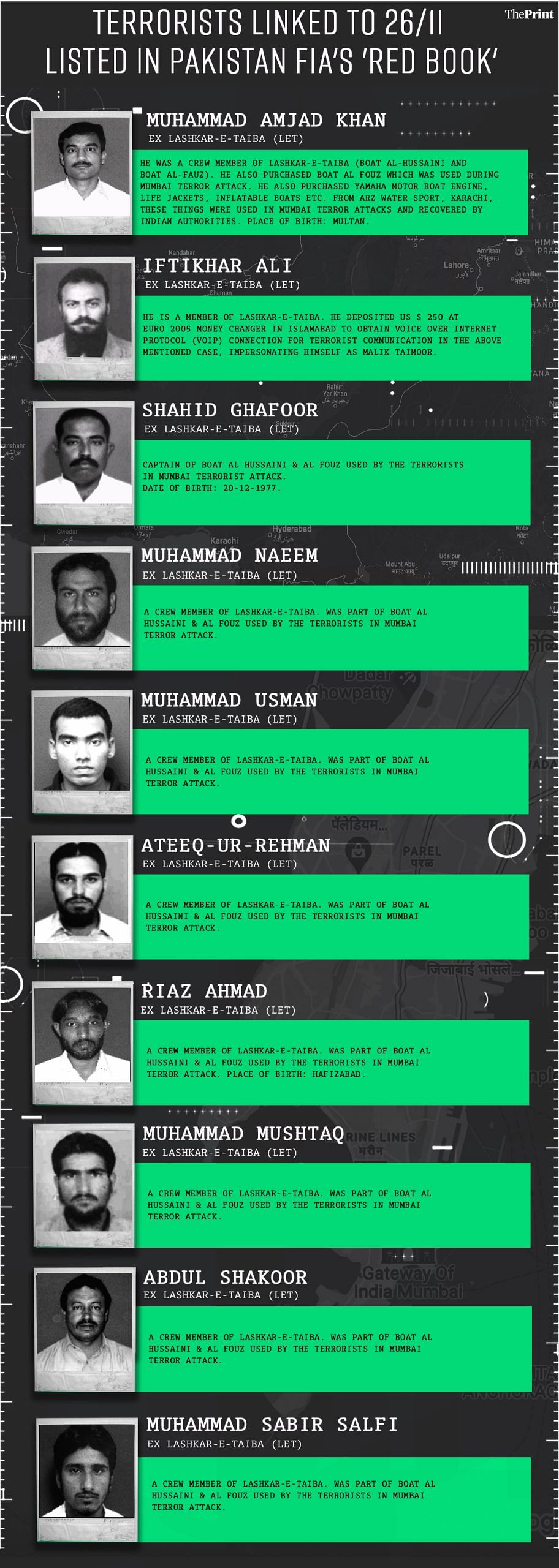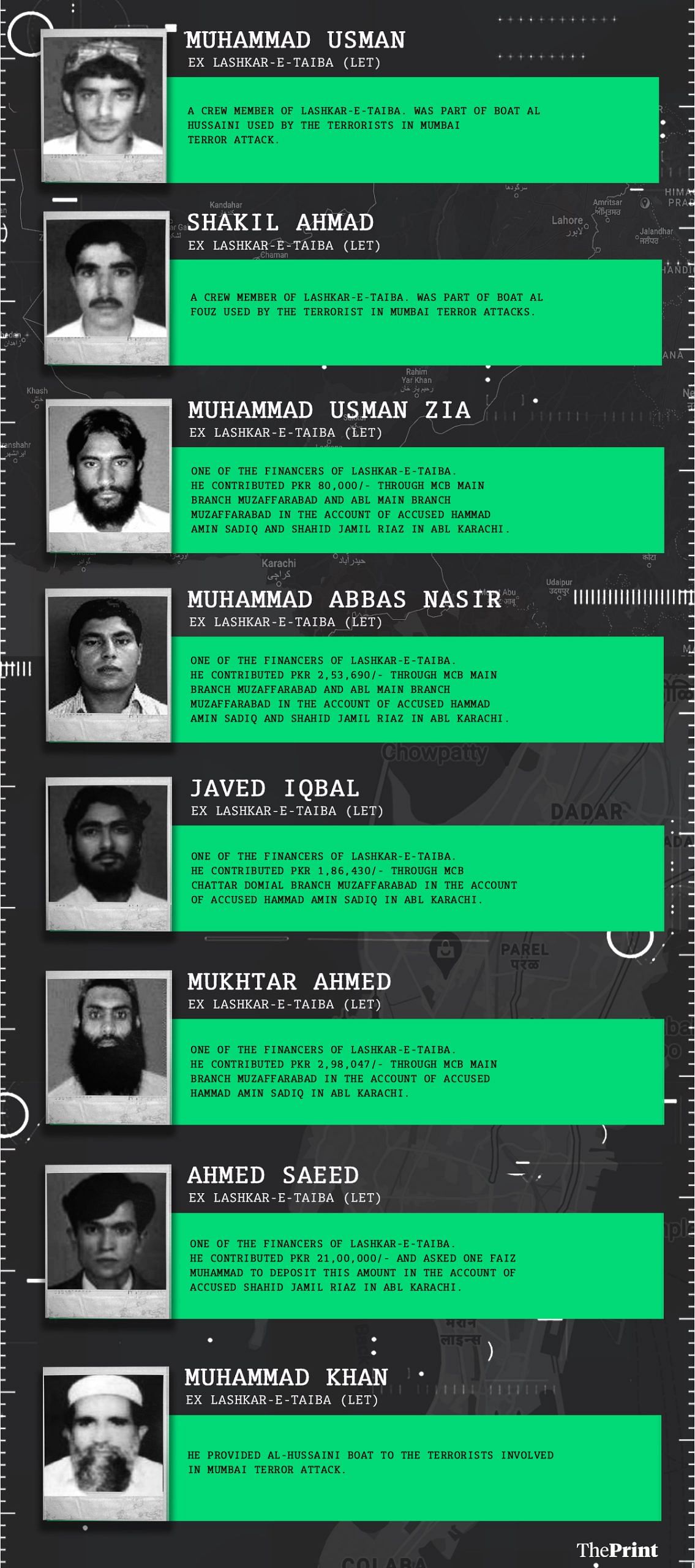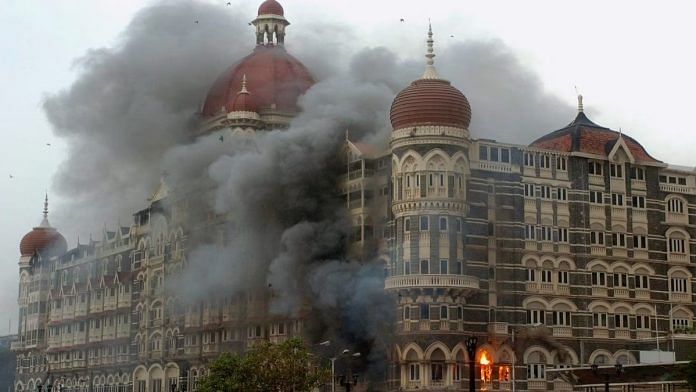New Delhi: Eighteen Lashkar-e-Taiba (LeT) terrorists identified as participants in the 26/11 terror attack are yet to be located, even though investigators in Pakistan have managed to obtain precise addresses, photographs and identifying details, internal records of the country’s Federal Investigation Agency reveal.
The eighteen men are alleged to have raised funding for equipment used in the November 2008 attack and to have crewed two fishing boats used to carry the assault team to Mumbai.
Listed in the FIA’s so-called Red Book, which contains the names of Pakistan’s most wanted terrorists, the eighteen men include Bahawalpur-based Shahid Ghafoor, the captain of the fishing-boats al-Hussaini and al-Fouz, and Khyber Pakhtunkhwa-based Ahmed Saeed, who raised PNR 21,00,000 for the attack.
Faisalabad resident Iftikhar Ali, alleged by the FIA to have paid $250 for the encrypted online phone link that allowed Lashkar controllers to communicate with the attackers also figures in the list, together with Multan-based Muhammad Amjad Khan, who purchased the outboard motor-powered dinghy which carried the terrorists on to shore in Mumbai.


Even though an anti-terrorism court in Pakistan began the prosecution of seven men the FIA alleges trained and equipped the attackers in 2009 — among them top Lashkar commanders Zaki-ur-Rahman Lakhvi, Abdul Wajid and Mazhar Iqbal — has been stalled because of procedural issues.
The anti-terrorism court has been demanding that 27 witnesses from India appear before it in person to give evidence, and be cross-examined by lawyers for the defence. For its part, India has offered to produce the witnesses online but the court has so far declined to entertain the request.
“Finding these accused should have been of critical importance to the FIA,” an Indian intelligence officer told ThePrint, “because they will be able to provide direct eyewitness testimony on the role played by various senior operatives who are being tried.”
“It is hard to believe that despite having photographs and identifying details, the FIA has been unable to locate even one of the eighteen men.”
The only survivor of the attack team, Lashkar terrorist Mohammed Ajmal Kasaab, was hanged at Yerwada jail in 2012.
Lakhvi — who infamously enjoyed luxury privileges while held in Adiala prison — received bail in 2015. Though several senior Lashkar leaders, including Lakhvi, were later convicted on terror-financing charges, there have been no convictions in the FIA’s 26/11 case.
Top Lashkar operative Sajid Mir — who was heard ordering the execution of Israeli hostage Rivka Holtzberg in intercepted audiotape officially released by India last year at a UN Security Council counter-terrorism committee meeting — has also been convicted by a military court in Pakistan. The nature of the charges and evidence, though, are unknown.
In a 2018 interview, former prime minister Nawaz Sharif had alluded to pressure on the investigation by Pakistan’s intelligence services, saying: “Militant organisations are active. Call them non-state actors, should we allow them to cross the border and kill 150 people in Mumbai? Explain it to me. Why can’t we complete the trial?
Also Read: 26/11 accused Tahawwur Rana to be extradited, but main players remain protected in Pakistan
New insights into 26/11
The Red Book’s listings provide new insight into the complex network of operatives the Lashkar used to support the ten-man assault team that killed at least 166 people.
The eighteen men are all identified in the Red Book as members or former members of Lashkar, suggesting that the terrorist group used trained cadres for each element of the operation, down to crewing the boats used in the attack.
According to the Red Book, the boat al-Hussaini was provided to Lashkar by Muhammad Khan, a resident of Shahdad in the narcotics-trafficking hub of Balochistan’s Turbat. The second boat used in the operation, the al-Fouz, was purchased by Muhammad Amjad Khan, who also bought the dinghy, the FIA says.
While the al-Hussaini was either scuttled or sunk after 26/11, the FIA claims, the al-Fouz was found at dock in Karachi.

The boats, the Red Book records, were crewed by Sahiwal resident Muhammad Usman, Lahore resident Ateeq-ur-Rehman, Hafizabad resident Riaz Ahmad, Gujranwala resident Muhammad Mushtaq, Dera Ghazi Khan resident Muhammad Naeem, Sargodha resident Abdul Shakoor, Multan resident Muhammad Sabir, Lodhran resident Muhammad Usman, Rahim Yar Khan resident Shakil Ahmad.
FIA investigators have not so far revealed whether these individuals received special training to operate the fishing boats, or were recruited from among existing crews.
The financiers of the operation included Muhammad Usman Zia, of Rawalpindi, who provided PNR 80,000, and Khanewal resident Muhammad Abbas Nasir, who contributed PNR 2,53,690. Kasur resident Javed Iqbal gave PNR 1,86,430, while Mandi Bahauddin resident Mukhtar Ahmed put in another PNR 2,98,047.
Likely raised from networks of local Lashkar sympathisers and supporters, the funds were deposited in bank accounts held by Hammad Amin Sadiq and Shahid Jamil Riaz, investigators had earlier shown.
Evasive conduct
Even though some Lashkar leaders are being prosecuted for their alleged role in the 26/11 terror attack, there is still no trace of several other critical figures alleged to have had close links to the Inter-Services Intelligence (ISI).
For example, Muzammil Bhat, alleged to have trained several members of the attack team, disappeared after a raid on a Lashkar camp near Muzaffarabad in December, 2008. There is no mention of Bhat in any legal documentation in Pakistan.
For years, Pakistan denied knowledge of the whereabouts of another top 26/11 operative, Sajid Mir. Faced with the threat of sanctions by the multinational Financial Action Task Force (FATF), however, media reports later quoted Islamabad as saying that it had tried and convicted Mir in a military court. His current whereabouts are unknown.
There is also no clarity on whether the other suspects together with Lakhvi have been, or may be, similarly tried by military courts.
(Edited by Amrtansh Arora)
Also Read: Pakistan again cultivating Lashkar, Jaish as loyal proxies. And why China’s got its back



